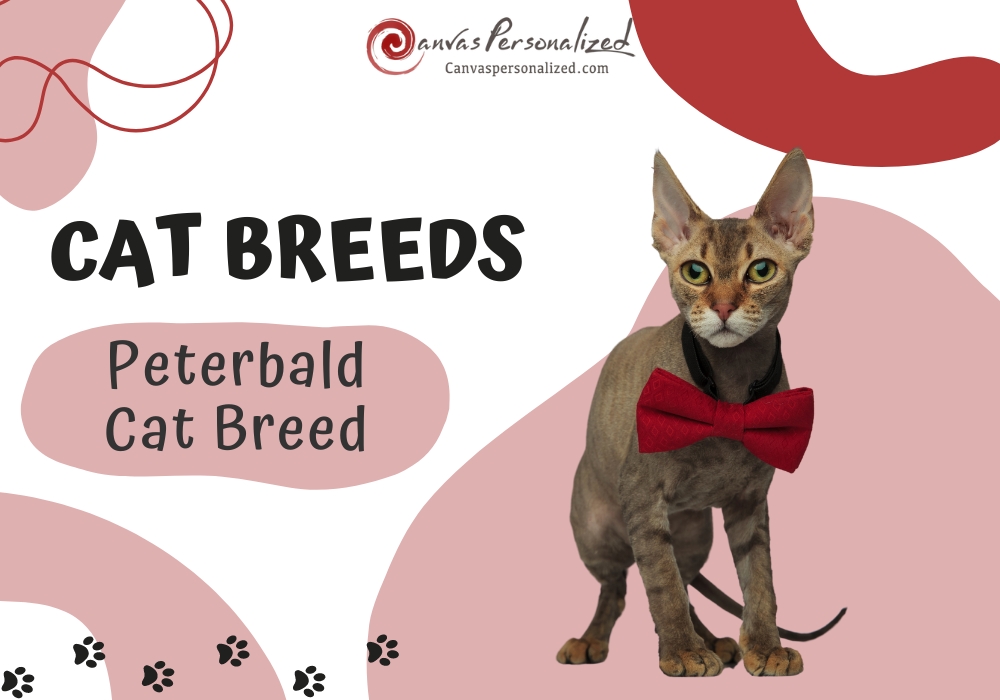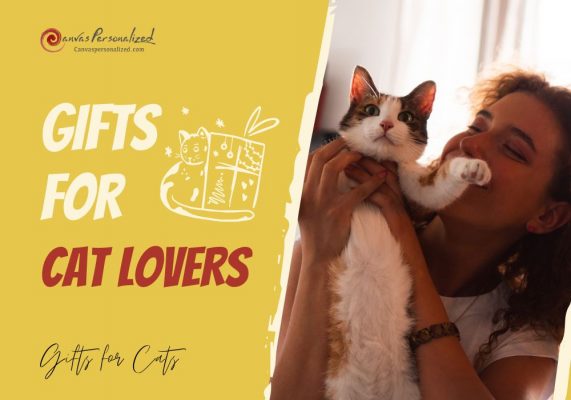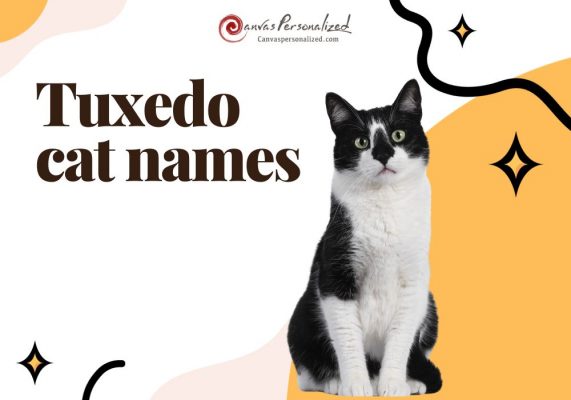Are you interested in cats that resemble aliens? Do you seek an intelligent, loving, and entertaining feline friend? Then it would be best if you looked into the Peterbald cat breed, which is among the rarest and most exotic. These kittens, developed in Russia in the 1990s, are entirely or virtually hairless. In this article, Canvas Personalized will provide an in-depth look into Peterbald, including information on its history, traits, health, and care.
Key Figures About the Peterbald Cat Breed
| PERSONALITY | Friendly, affectionate, interactive, outgoing, intelligent |
| WEIGHT | Up to 14 pounds |
| LENGTH | Up to 17 inches |
| COAT LENGTH | Hairless, flock, chamois, brush, or straight |
| COAT COLORS | White, black, red/orange, gray, fawn, or lilac |
| COAT PATTERNS | Solid, bicolor, tabby, or color point |
| EYE COLOR | Gold, green, or blue |
| LIFESPAN | 10-12 years |
| HYPOALLERGENIC | Yes |
| ORIGIN | Russia |

1. The History of the Hairless Peterbald
In the Russian city of Rostov on Don, 1988, the Peterbald cat’s ancestry was discovered. The Don Sphynx, a hairless cat with an odd appearance, gained widespread public attention.
Don Sphynx felines soon made it to Europe, where it was observed that not all newborn kittens had fur. The breeders looked into the genetics of the matter to figure out what characteristics the parents of hairless cats needed to have.
Although numerous hypotheses have been advanced, no definitive formula has been developed for breeding hairless Peterbald cats. Peterbald cats bred nowadays continue to have a wide range of coat colors. Geneticists are still investigating why this occurs.

In 1994, Feline expert Olga S. Mironova of Russia bred a Don Sphynx named Afinguen Myth with an Oriental shorthair cat named Radma Von Jagerhof. The first two litters produced the first four official Peterbald kittens: Mandarin iz Murino, Muscat iz Murino, Nezhenka iz Murino, and Nocturne iz Murino.
Nocturne iz Murino was chosen as the breed’s stud. Today, his DNA may be found in every pedigree Peterbald cat.
The International Cat Association (TICA) recognized the Peterbald cat breed in 1997. In 2003, they were recognized by the World Cat Federation. By 2009, TICA had approved them for competition in the championship class.

2. The Peterbald Characteristics of Appearance
According to this breed standard, the cat can have fur in any of the following Peterbald coat types:
- Peterbald Naked: People are probably most familiar with Peterbalds that are completely hairless or have short hair on the face, paws, and tail. Within this type is an even more hairless variant known as the “ultra-bald” variety, which lacks even eyelashes and whiskers.
- Peterbald Chamois: A coat of very fine fuzz described as touching silky. It can cover the cat’s full body or only show in areas around the limbs and tail.
- Peterbald Flock: A coat of varying lengths that is as soft and fluffy as the undercoat of a long-haired breed. This coat is exceptionally soft and smooth to the touch.

- Peterbald Brush: A coat (again, with various lengths) constructed completely of guard hair that has been slightly twisted. This coat is usually coarser and more rigid to the touch.
- Peterbald Straight: A coat completely devoid of the Peterbald characteristic and resembles a regular short cat coat. Straight-coated Peterbalds are genetically similar to their bald relatives. They can be registered as Peterbalds but are not championship material and should only be maintained as pets or for breeding.

Occasionally, a multicolored Peterbald will develop a coat with two unique hair types: the white areas will have soft, downy hair, while the darker areas will have wiry, harsh hair. The coat of your Peterbald kitten may alter throughout time, no matter which of the above categories he was born into. Within the first two years of life, nude Peterbald kittens develop coats, while straight-coated kittens lose all their hair. Peterbald whiskers are similarly unpredictable, taking on a variety of shapes and sizes, textures, and even disappearing entirely in some instances.

Peterbalds are medium-sized cats with long, slim bodies, a tight tummy, and a wedge-shaped head. Their ears are usually comically enormous, rounded triangles that take up much space on the sides and tops of their heads.
Their eyes are often green in color. These are rather big and almond-shaped. Their tail is wavy and lengthy.
3. The Peterbald Cat Personality
The Peterbald cat possesses a sense of loyalty that many other felines do not. In fact, this kitten is sometimes compared to a puppy because of its excessive human attachment.
There are few cat breeds as friendly and entertaining as the Peterbald. To keep them happy, you should never leave them alone, as their high social needs necessitate regular company. The good news is this Oriental Peterbald cat, like its relatives, may develop deep connections with canine and feline friends.
Peterbalds are active and playful pets. They spend their days exploring their environment and climbing high spots to survey their territory.

>>> Does my cat love me? Learn how to decode a feline’s behavior and understand the signs of affection from your Peterbald companion!
4. How to care
Nutrition
Despite not having any unique nutritional requirements, Peterbald cats perform best on a high-quality diet with either fish or meat as the primary protein source. These cats may require slightly more food than ordinary cats due to the extra energy they expend through their antics.
>>> Can cats eat donuts? Find out the answer and the potential risks of feeding your feline friend with this sweet treat!

Grooming
The Peterbald, like other hairless cats, needs regular baths. This is essential because there isn’t enough hair to soak up all the oil that the skin generates. Extra oil can cause discomfort and bad smells because it attracts dirt. Families with a Peterbald kitty should always have a mild shampoo and a warm, soft towel to dry their pet’s fur.
Exercise
Peterbald kittens do not need to be encouraged to play. These playful cats keep their playful spirit until adulthood. They are always up for a good time, whether with a group or alone. You should provide your cat with various scratching posts, a basket of toys, and a tall cat tree.
Pet parents of Peterbalds should make sure their pets never lack suitable entertainment. These felines may improvise with whatever is available if they don’t have access to cat toys, including household appliances.

5. Common Peterbald health issues
This hairless Peterbald is known to be healthy in general. However, some cats can develop feline ectodermal dysplasia, a skin disorder. Even if they do not have this unpleasant skin disease, these felines are vulnerable to harm if they are subjected to harsh handling by children, competing cats, or overeager dogs. These hairless cats must also be protected from the weather since they are susceptible to exposure to sunburn, windburn, and other skin disorders caused by exposure.
Peterbald’s eyesight is occasionally impaired. A hereditary disorder called progressive retinal atrophy causes gradual visual loss in cats. This is due to the gradual depletion of the retina’s photoreceptor cells over time. As early as 18 months of age, this disease can manifest. By age 3, a cat with this illness may be completely blind.

6. How Much Do Peterbald Cats Cost?
Given their concise history, Peterbald cats are a rarity. You won’t find one of these cats for free, as it is one of the most costly cat breeds in the world. The Peterbald cat price varies depending on the source.
Peterbald cat Adoption
Although the cost of rescuing a cat will be less than purchasing one from a breeder, you should still budget between $500 and $2,500 or more. Some Peterbald cats may not be purebred, so it’s essential to check their paperwork to adopt one.
Peterbald cat Breeder
A Peterbald kitten from a breeder will cost substantially more than one from a Peterbald cattery, ranging from $1,700 to $4,000. When purchasing one of these unique cats, it’s essential to do so from a reliable breeder who can guarantee the animal’s legitimacy.

>>> Get inspired and choose a gift to welcome your Peterbald kitten home!
7. Peterbald cat facts
- The baldness gene in Peterbalds is dominant. Thus, they can have hairless kittens by breeding with other cats.
- Along with the Sphynx, Donskoy, Bambino, Ukrainian Levkoy, and Elf, the Peterbald is one of only six hairless cat breeds in the world.
- Peterbalds have a much higher caloric requirement than other cats due to their rapid metabolism. If you want to make sure your Peterbald is getting a healthy and balanced diet, it’s best to talk to the vet.

>> Read more about cat breed on Canvas Personalized:
- Oriental Longhair Cat: A Stunning Feline With Captivating Personality
- Savannah Cat Breed: Exotic Elegance and Wild Spirit
In conclusion, the Peterbald cat breed is one of the most fascinating and distinctive felines within the realm of hairless cats. They are clever and affectionate cats that can make excellent pets for anyone who can appreciate their uniqueness. If you’re interested in pet breed behavior and training, Canvas Personalized contains a wealth of information to help you.










